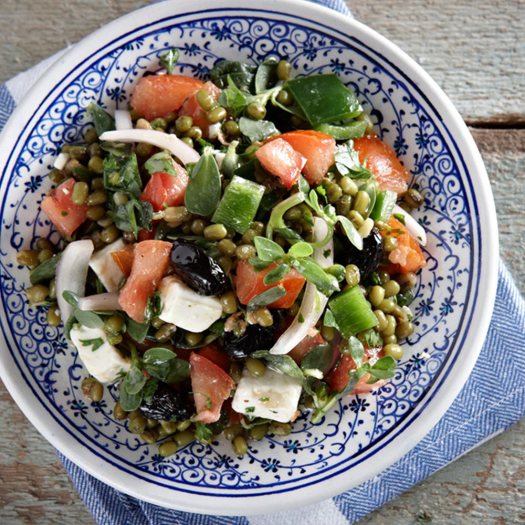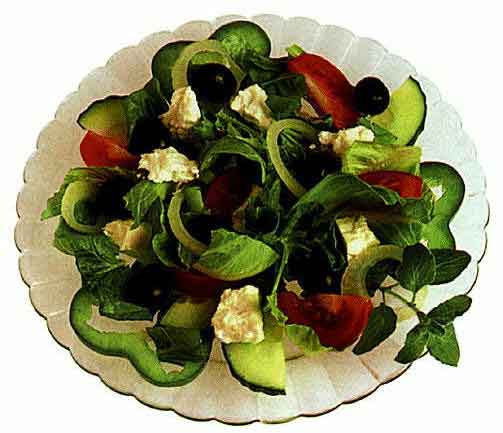Classic Greek salad recipe
Encyclopedia of Greek salad: ingredients, dressings, rules, tips, classic Greek salad recipe and its many modifications:
The most famous Mediterranean salad
Let's start with the incredible: in Greece there is everything except... Greek salad! No, of course, in numerous restaurants aimed at welcoming and entertaining foreign tourists, the staff has learned well that when asked whether they have the above-mentioned salad on the menu, they should answer in the affirmative and at the same time vigorously nod their heads to hide their own attitude to such a widespread myth. However, the truth is that what we call Greek salad, in Greece itself (as well as in many other Mediterranean countries) is called dozens of different names, among which there is not only the one to which we are accustomed.
The most common local "name" that a hero bears today’s article is “village salad” (in the original language – χωριάτικη σαλάτα, “horyatiki salad”), which very eloquently, accurately and completely reflects the essence of the treat served to guests: natural products, affordable, amazing in quality. The second common name is banal and obvious: vegetable salad. However, they say that over the past few decades, another name for Greek salad has come into use among Greeks - Russian salad: apparently, our compatriots order it en masse in restaurants, tightly linking the Greek dish with their own customs.
To avoid any further confusion, let's just agree that Let’s allow ourselves to make allowances for our own traditions and call a dish of fresh vegetables and cheese, which is widely prepared in Mediterranean countries, a Greek salad, however, at the same time, we will certainly keep a small notch in our minds as a reminder of how correctly it should be called.
So, let's go over the basic components of a Greek salad, shall we? Special The value of this dish is due to the fact that it contains almost everything that a person needs: proteins, fats, carbohydrates. A portion of a delicious salad, rich in taste and charming in its color saturation - and we can consider that a full meal has taken place. The salad recipe is optimal: such a lunch not only gives you a feeling of fullness for a long time, but also normalizes metabolism, delicately cleanses the intestines, and saturates the body with useful substances and microelements.
Ingredients for Greek Salad
Tomatoes
If you think that Greek salad can be made from semi-plastic, tasteless and odorless greenhouse tomatoes that lie in neat, beautiful rows on supermarket shelves, you are committing a crime against the entire Greek healthy eating culture.
A prerequisite for a real Greek salad is aromatic tomatoes grown in the open ground, preferably farm or village tomatoes. Ideally, tomatoes grown with your own hands in your personal garden.
There are no restrictions regarding the variety of tomatoes. Depending on your personal preferences, you can choose fleshy red tomatoes, juicy pink ones, rich black ones, or discreet yellow ones.
cucumbers
The rule regarding the method of growing tomatoes is equally true for cucumbers: the fruits should be fresh, firm, juicy and very aromatic. Limp green sticks, which are offered in abundance in modern stores, are absolutely not suitable for Greek salad.
If a crazy thought runs through your head to peel the skins from the fruit, take a good old broom and shoo it away. No self-respecting Greek would deprive cucumbers of their important component!
bell pepper
We remember again that Greek salad is a rustic and simple dish, and we pass by the ideal bell peppers that can be purchased at the supermarket. If you don’t have access to a private garden, your destination is a farmer’s market, where grannies with string bags, sturdy grandpas on bicycles, and lively, rosy-cheeked young ladies in colorful scarves come.
Choose elastic fruits with a fresh stalk: if it has wilted, this indicates that the pepper was picked several days, or even weeks ago. They can be used for stuffing or making sauces, but they are completely unsuitable as a component of Greek salad.
Feta
Do you want to make a Greek salad or a salad similar to Greek? This point is very important when it comes to cheese. The fact is that, according to a decision approved in 2007 in the EU, feta can only be called cheese of Greek origin, made from cow's or sheep's milk. Anything you buy in stores with that name that is not made in Greece is not feta.
Thus, it turns out that an authentic Greek salad can only be prepared using cheese brought from a distant and sunny country on the Mediterranean coast. You can buy real feta in supermarkets, but few people dare to spend a lot of money on something that has domestic analogues that are no less worthy and of high quality. Which cheese to buy to make a real Greek salad, of course, is up to you to decide.

Olives
To make a Greek salad, you will need quality pitted olives. When choosing a product, try to avoid anything canned in metal cans with attractive labels; look for small shops that specialize in selling goods from Italy or Greece - it is in these shops that you can buy pickled olives and black olives of the highest quality. You want juicy, firm fruits that are a beautiful chocolate color with a distinct eggplant tint. Options with filling inside are good and tasty, but are completely unsuitable for making a real Greek salad.
Olive oil
Many famous chefs believe that high-quality olive oil is a third of the key to success: it is what unites disparate components into a single whole, enveloping them in the extraordinary spirit of the Mediterranean. Naturally, we are talking about extra virgin olive oil, which is obtained by mechanical extraction.
This oil does not contain any additives, has a rich taste and aroma and is extremely beneficial for human health. Please note that the color of Extra Virgin Olive Oil should not be close to yellow and amber tones, but rather green - thick, rich and grassy. The taste of this oil is very characteristic - it is barely perceptibly bitter, stunning with a mixture of salty, sour and sweet, striking in its richness, surprising in its subtlety.
Onion
Those in the know say that the perfect taste of a Greek salad largely depends on how you prepare the onions. Yes, yes, just cook it - there are a lot of recipes for Greek salad on the Internet, but only a few sources lift the veil and say that before adding onions to the salad, you should remove bitterness, harshness and anger from it. The taste of this dish should make you love the world and enjoy people, so you need to peel the onion, cut it into rings and put it in the marinade prepared in advance for a couple of minutes: a little hot water, salt, a spoonful of sugar. When removing the onion from the marinade, under no circumstances should we squeeze it or deform it; it should remain intact and beautiful.
Oregano
Oregano is the main Greek culinary herb, it is added wherever possible - the taste of many Greek dishes has an "oregano" accent. You can, of course, season the salad with Italian basil, French rosemary or Georgian cilantro, but it won't be quite a Greek salad, or even a Greek salad at all. Oregano (although it is nothing more than oregano) is a magical herb, do not neglect it if you decide to experience the true taste of an authentic classic dish.

Classic Greek salad recipe
Of course, there is no need to talk about any clear recipe with the exact amount of each ingredient, however, a certain formula-proportion can be derived. A basic Greek salad recipe is needed for orientation - once you feel the overall balance of ingredients, you can experiment and play with additives to suit your own taste.Ingredients:
- 1 cucumber;
- 1 tomato;
- 1/3 bell pepper;
- 1/2 blue onion;
- 5-7 olives;
- 80 g feta;
- salt, a pinch of dry oregano;
- 50 ml olive oil.
How to make Greek salad
Wash the vegetables, cut them into large pieces. Place in a salad bowl.
Peel the onion, cut into half rings, and marinate a little if desired. Place in a salad bowl.
Add olives without brine.
Salt. Mix carefully.
Place a few slices of cheese on top of the vegetables. Even more correctly - solid - one! - hunk. This is an old village tradition. Different from the modern fast food style of cutting feta into cubes.
Sprinkle with oregano.
Drizzle the salad generously with olive oil and serve. Can be with a slice of lemon.
Dressings and dressings for Greek salad
The classic Greek salad is dressed with premium olive oil, however, variations are also allowed that will diversify the taste of the salad and make it interesting and unusual.
Try making a dressing using olive oil and lemon juice. You can add a little white wine and balsamic vinegar. A drop of honey, soy sauce, narsharab, a little grain mustard, and orange zest will make the dressing even more original.
The main rule for preparing salad dressing is that the sauce should be very rich in taste, but pleasant. If you have prepared the dressing, but you don’t like it (yes, you must try it first!), the salad will not fix it; rather, it will ruin the salad itself.

Ways to diversify a classic recipe
There are many options that allow you to diversify the usual village salad. In some recipes, it certainly includes lettuce. Lightly salted salmon and canned tuna, boiled cold pasta and baked bell peppers, cooked lentils and raw cauliflower, capers and anchovies, avocado and mushrooms - everyone chooses additives according to their taste and budget.
By the way, another option is endive leaves. They are good not only for their extra flavor - they are great for serving salad in portions. It turns out unusual and stylish.
Serving options
Greek salad is so popular all over the world that numerous experiments in serving it became a natural progression of the development of this dish.
Many chefs of famous restaurants build “towers” of vegetables, alternating them with cheese. It can be served in “boats” of bell pepper or lettuce, in pita bread and on toasted slices of bread, in small glasses in the style of verrines and huge bowls, the contents of which can feed half of China.
Vegetables are laid out on a plate in bright multi-colored rows, alternated in appetizing layers in a salad bowl, roughly cut into a couple of pieces, carefully cut into small cubes - there are a lot of options for serving Greek salad, and it seems that every day chefs from all over the world come up with new and interesting ways to treat their guests with a delicious dish of fresh vegetables and delicate soft cheese.

5 rules for a real Greek salad
To summarize, I would like to write separately about the basic and very important rules, without which you will prepare anything but a Greek salad.1. The ingredients for the Greek village salad are chopped coarsely. No, not just large, but as large as possible - they must hide maximum taste, plus it is unacceptable to spend more than 5 minutes on preparing the most ordinary everyday dish.
2. Do you prepare salad for yourself and your family? Then put your doubts aside– and mix the contents of the bowl with your hands. Ru-ka-mi! This will not only add soulfulness to the salad, but will also allow you to keep the vegetables intact without crushing or even crushing them.
3. When adding olive oil, you should not only pay attention to its quality (only the best, only proven!), but also to the quantity. The canonical Greek salad should be oily, very oily - no real Greek woman will spare olive oil, because she knows that after the salad bowl is empty, there will be a delicious “juice” from the vegetables, cheese and dressing at the bottom. Greeks dip pieces of freshly baked bread into this liquid and enjoy the extraordinary taste of homemade food.
By the way, for this process the inventive people of the sunny country even invented a separate word - “ladobukies” (“butter pieces”), which means a completely indecent, but incredibly tasty dipping of bread in salad sauce.
4. Don't cut the cheese. Limit yourself to one large slice, which is laid out on top of the vegetables. It’s more beautiful, tastier and more “Greek” this way.
5. Greek salad is prepared immediately before serving, and when served, it is eaten immediately. It does not need to be infused; the products should be as fresh as possible and just chopped.

The history of Greek salad
They say that the birth of salad occurs in the 20-30s of the 19th century. The fact is that tomatoes, one of the main components of Greek salad, appeared on the territory of this country only in 1818 - and it was after they almost instantly gained popularity and popular love that they began to be used in salads.
However, history claims that it was only a prototype of the modern Greek salad - let's say, its distant genetic ancestor, nothing more. At the time when the first tomatoes and onions appeared in Greece, these vegetables were not cut into pieces, but were eaten exclusively whole. Only almost a century later, with another wave of emigrants, one of the Greeks came to the United States, who figured out how to prepare their favorite dish in a slightly modified format - after cutting vegetables into small pieces.
In Greece, among other things, there is a proverb: if you know the village salad, you get to know Greece (or another wording: the village salad is all of Greece in one plate). Enjoy the taste of fresh vegetables and soft cheese and get to know Greece!




